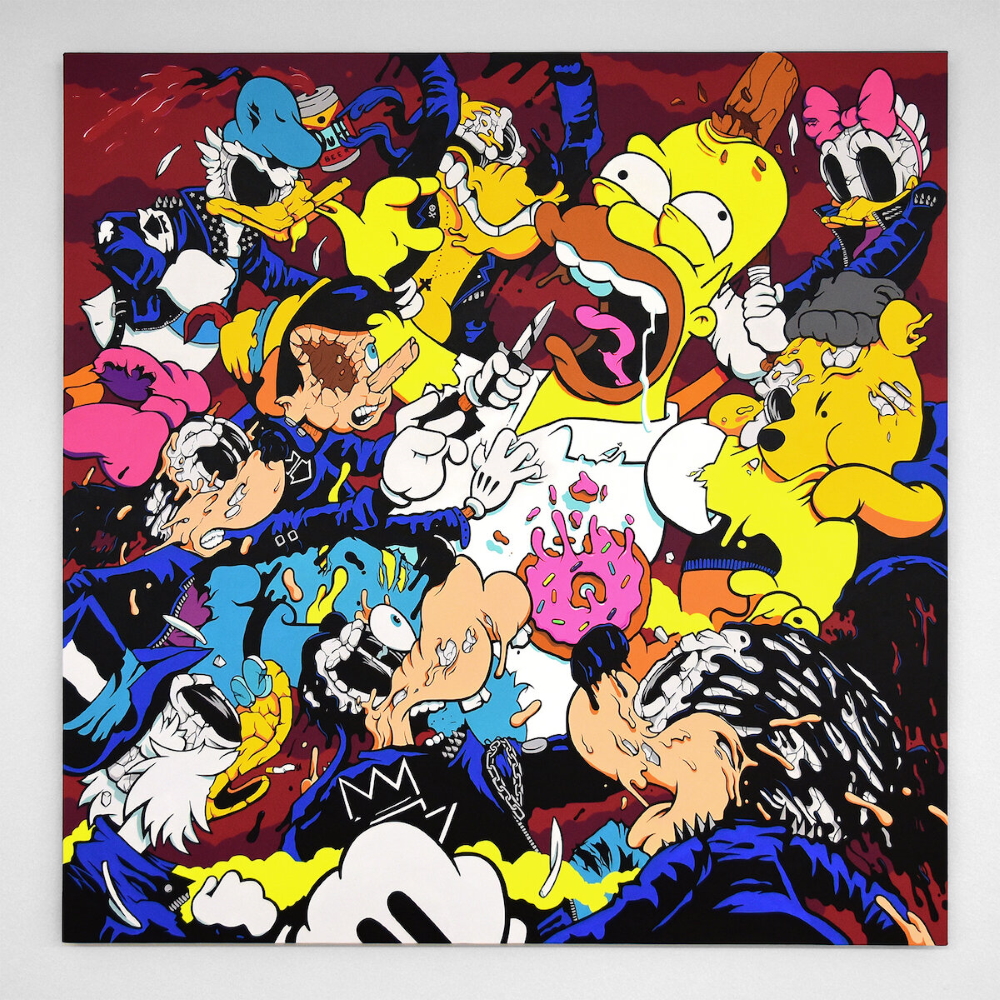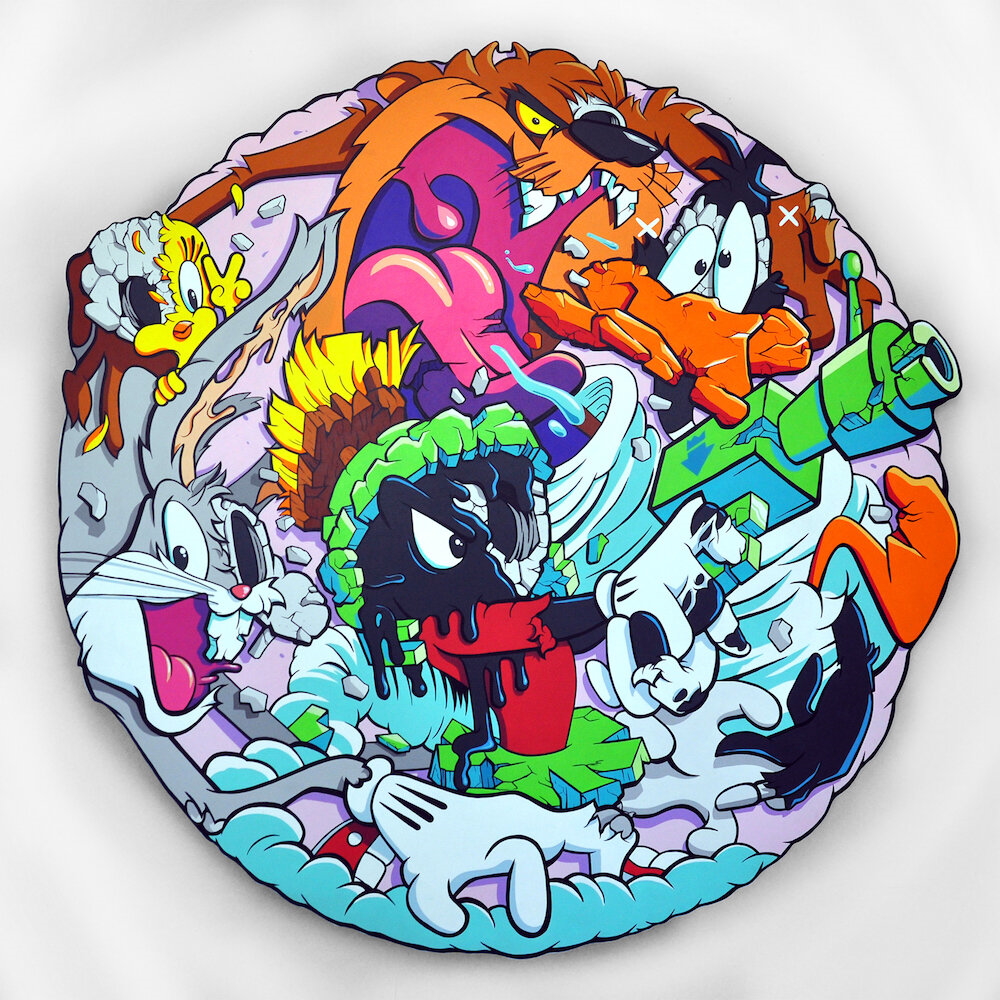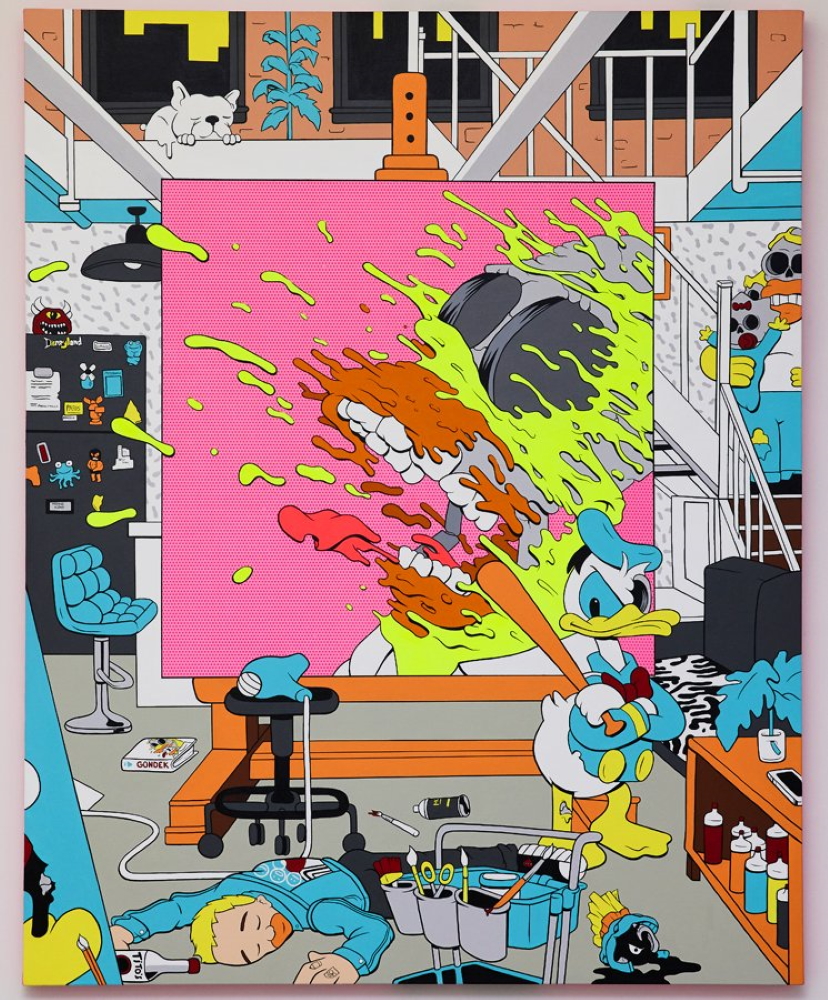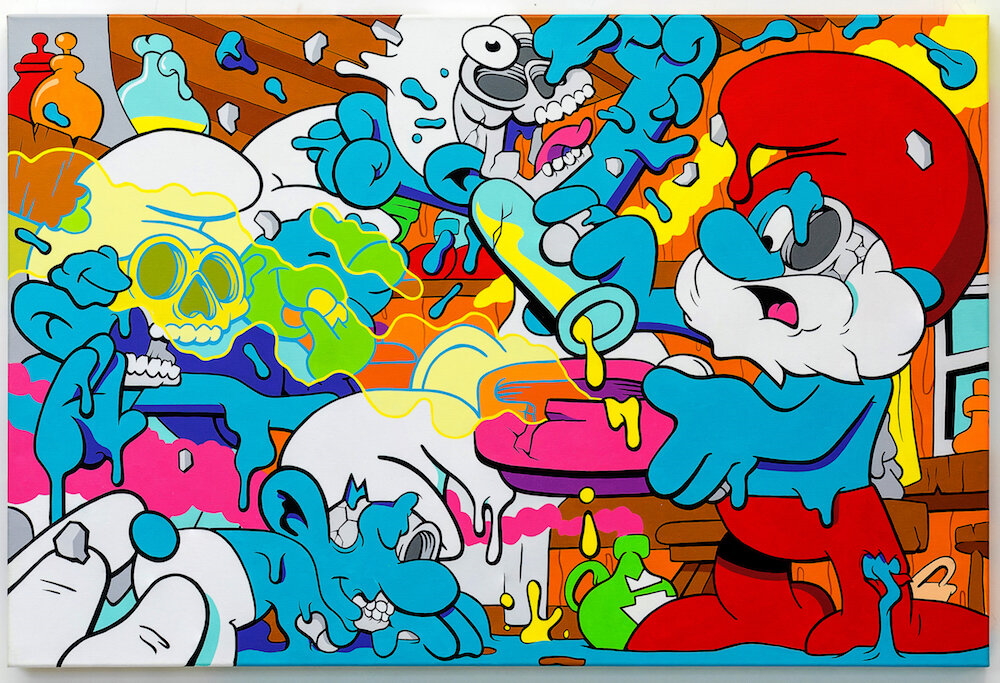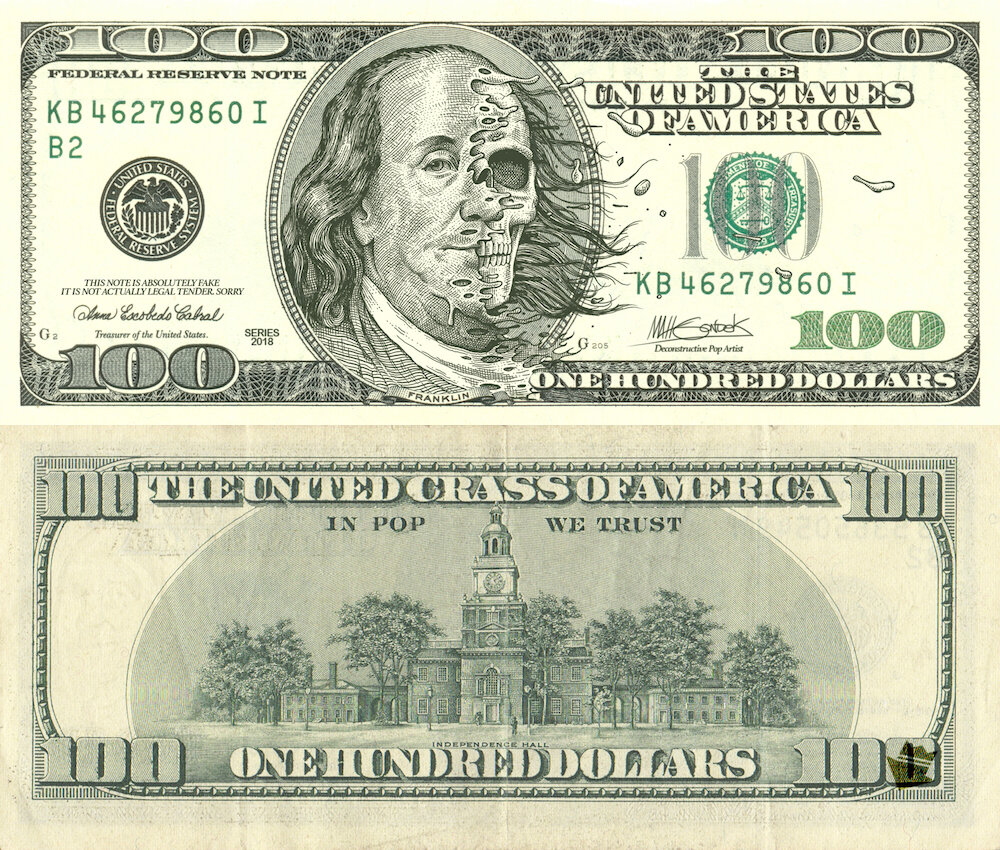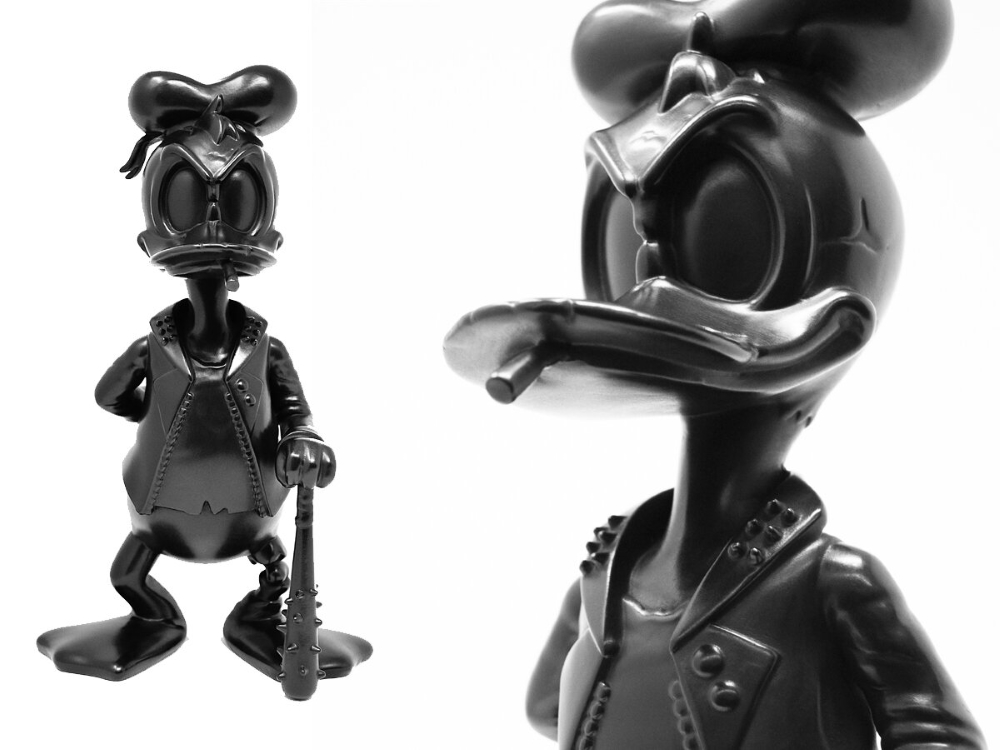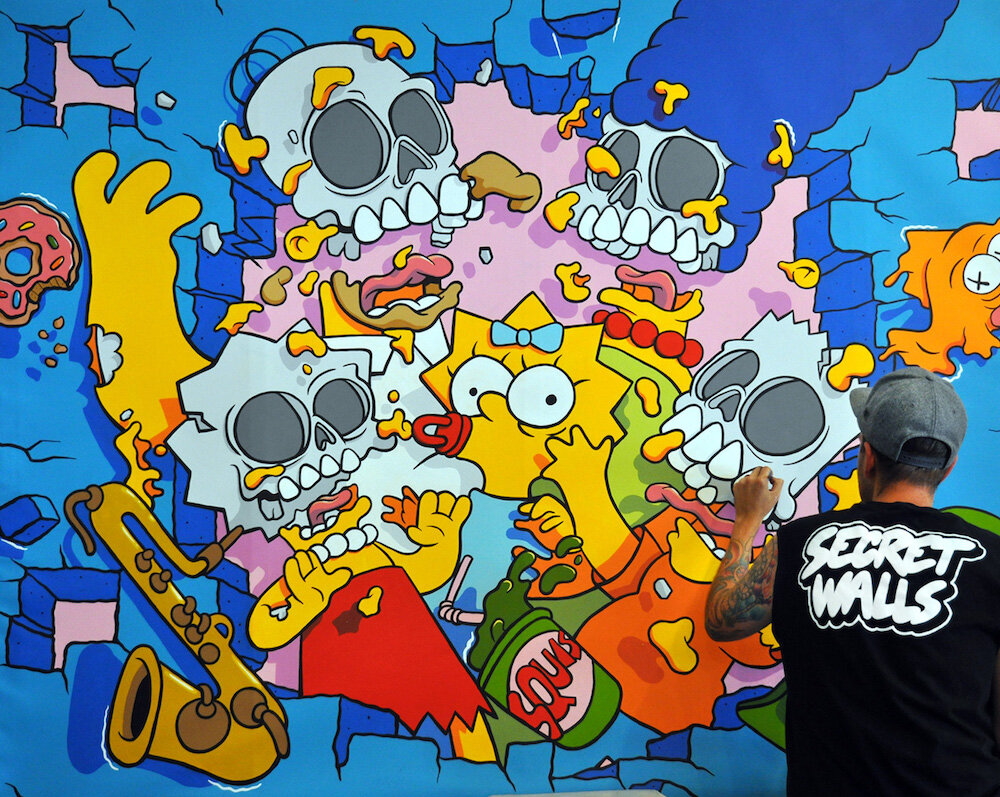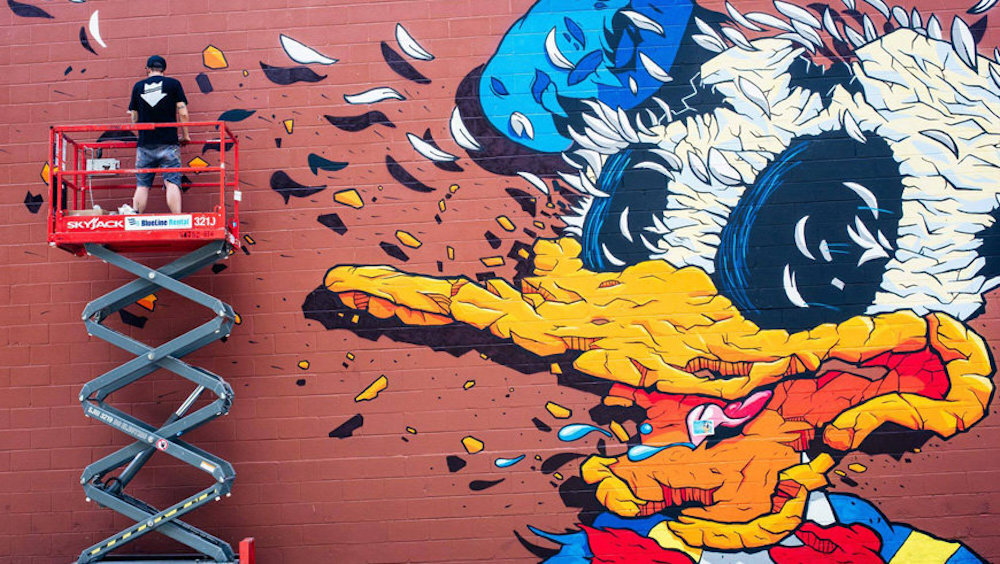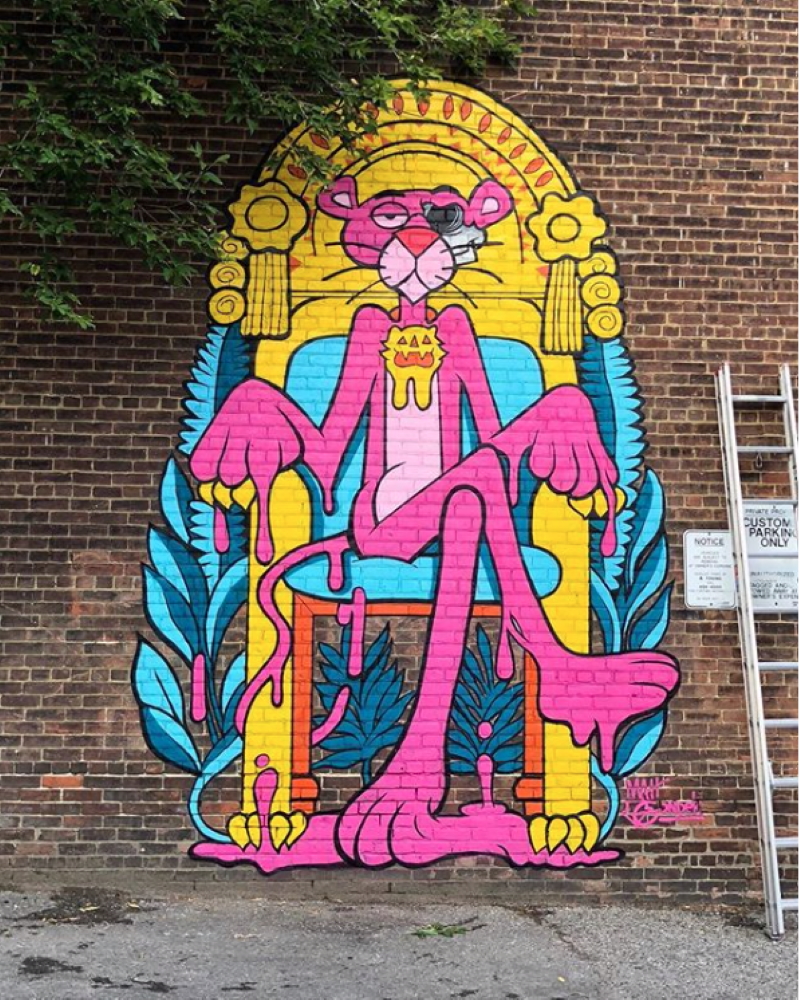Matt Gondek
deconstructive pop artist / illustrator
US
Mickey Mouse. Donald Duck. Pluto. Winnie The Pooh. Bugs Bunny. The Simpsons. SpongeBob SquarePants. Family Guy. Beavis and Butt-Head. Kid Goku from the cult anime series Dragon Ball Z. Comic/cartoon icons like these don’t appear here just as they are familiar, but like one never has imagined and seen them before, because the characters is given a very special pop-art makeover! Mickey Mouse is a skeletal here, Homer Simpson is melting. How could this unique action-packed painting style with its clean, bold lines and bright, vivid colors which refers to the origin of the comic books‘ archetypes be called? ‚Deconstructed Pop Art‘!
Matt Gondek
deconstructive pop artist / illustrator
US

It is rare for frustration and anger about a dull job to result in something productive, which then also becomes the basis for personal success. But that’s exactly what has happened to Matt Gondek, who created his first comic book when he was in elementary school. The self-taught artist from Pittsburgh (* 1982) was doing graphic design - especially merchandise in the music industry - and hated it. One day in 2012, when he lived in Los Angeles for a year already, „I had a freelance illustration project where it had me drawing Mickey Mouse“, the advocat of the Do-it-yourself-method told streetartnews.net. „It was 30 different drawings of Mickey Mouse. And just because I had to do it so many times I started designing all kinds of situations like dirty ones of Mickey having sex, him getting killed, getting shot, getting run over, but one drawing was just his head blowing up. It was a huge stack of Mickey drawings. I reached in and I randomly grabbed one that turned out to be the Mickey head blowing up one and said to myself ‚I’ll just paint this one‘.“ That coincidence was what led him to painting professionally and motifs like these in particular. After having completed a number of works (Acrylic on canvas mostly), an art show in his hometown entitled „kill `em all“ was staged and sold all on the opening night already. This was the start of a stellar career for him who was influenced by Andy Warhol and is an admirer of Roy Liechtenstein. Since then works by GONDEKDRAWS (his pseudonym) are on display in galleries and outdoor on large murals.
Nowdays this man produces not only paintings on canvases, but creates a multi-media portofolio including sculptures plus designer toys, t-/sweatshirts, tote-bags, posters, prints, sticker packs and even NFTs („Non-Fungible Tokens is“, according to Wikipedia, „a unique digital identifier that cannot be copied, substituted, or subdivided and typically contain references to digital files“ – here of art). Despite all that commercialism the heart of a punkrock kid from the woods in Pennsylvania is still beating in him. That is shown by the fact that „a lot of the work is dealing (among various things) with a lot of my own inner turmoil, like fighting the things that I want versus what I need to truly be me“, he confessed in the streetartnews.net-story. „There’s this monster I’ve made, it’s basically a Kajiu version of Homer. I call it ‚Big Trouble‘, but it’s really a metaphor for greed. This giant green eye monster… the idea is this giant thing just rampaging around destroying everything. He’s in a lot of the paintings and everyone’s trying to fight him, but he’s still destroying everything. So it’s kinda like a very subtle metaphor. A lot of the work just has money in it. There’s this one painting where the character is holding a giant bag of money, but then he’s surrounded by people with their hands outstretched asking for some, and just having to deal with that kinda reality.“
Gondek’s works have been exhibited in Bangkok, Detroit, Hong Kong, London, Mexico City, New York as well as L.A. successfully and are part of private collections in Brasil, France, Germany, Canada, Sweden and the US.
Matt Gondek lives and works in Los Angeles.
Interview December 2022
Scar(r)ed for life: artistic deconstruction of Pop Culture icons
INTUITION/IMAGINATION
How does intuition present itself to you – in form of a suspicious impression, a spontaneous visualisation or whatever - maybe in dreams?
Intuition occurs sporadically to me. It’s always triggered by something visual. Seeing one hundred inspiring things, taking a piece here and there – until a new amalgamed idea is formed.
Will any ideas be written down immediately and archived?
I have so many small sketchbooks. I prefer little books that can be carried in a backpack or a pocket. I prefer to sketch out ideas small, so I don’t overcommit to rendering anything presentable. Strictly for ideas.
?: How do you come up with good or extraordinary ideas?
I wish I knew, so I could recreate that feeling more often. They just occur randomly and naturally. I do force myself into inspirational environments – like art museums or new experiences. Travel helps immensely.
Are great ideas based on intuition and do they reveal themselves in a kind of clear as well complete version that just has to be realized? Or is it endless trials and errors (after the first spark) that result in constant developments up until the final result?
Typically – for every ten ideas I have – one will be great. Every time I think of something – I’ll let it swirl around in my mind for about a week or so. If I forget about it – it’s a sign that it wasn’t a great idea. If it just won’t go away – I’ll take it to the next stage, which is sketching it / writing it down. If it just exports from brain to paper easily and flawlessly, I know it’s a good idea – and I’ll pursue it more, now investing time to draw it properly. Refining it, letting it sit for a day, and revisiting it again and again to cut the fat until it’s a simple and strong idea.
What if there is a deadline, but no intuition? Does the first fuel the latter maybe?
If a deadline is looming and I’m not having a divine source of inspiration – I will trudge forward with whatever idea has been presented and hope for the best!
INSPIRATION
What inspires you and how do you stimulate this special form of imaginativeness?
Growing up – comics, and street art, and punk rock inspired me. Those three things really stimulated me creatively in the beginning. As I’m getting older, my tastes are expanding and I’m finding more and more that inspires me. Museums, travel, food, interesting hotels, etc.
How do you separate the good from the bad and which ideas are worthwhile to be explored further or whether one idea has the potential of being outstanding really?
As I stated above. I allow all “good” ideas to live in my head for about a week before I do anything with them. If they’re not a great idea, they will quietly leave and be forgotten. The great ideas will keep getting louder and louder in my head until I do something with them.
Has it to appeal to you primarily or is its commercial potential an essential factor?
To me, a great idea scratches both - the itch of self-satisfaction AND commercial viability. I think both are essential for what I’m persuing.
Do you revisit old ideas or check what colleagues/competitors are up to at times?
I revisit old ideas all the time, mainly to redo old works with newly acquired skillsets. I think there was a lot of great ideas in my past work – but my skill level just wasn’t what I wanted it to be. These are the kinds of things I revisit.
Anyone who I view as a “competitor” – I do everything in my power to avoid seeing them or their work. I realized early on that I was worrying too much about what others were doing – so I try my best not to look. Colleagues however – I love seeing what they’re working on!
CREATIVITY
Which time/place/environment suits your creative work process the best (tranquillity or pressure) and which path do you take from theory/idea to creation?
Early in my career, I thrived in isolation. I would work alone at home. Over time, I do my best work in my studio with my team present. The ability to bounce ideas off them, and work in a high energy environment helps me immensely. I also thrive under pressure and always make sure I have one or two projects looming. I do my best work there.
What is better in the realization process: speed and force creativity i.e. grasp the magic of the moment, or a slow, ripening process for implementation/elaboration?
In a perfect world where money didn’t matter – every art piece would develop naturally with no time limit. But I live in the real world, where sometimes you have to develop ideas faster than you’d prefer too. Such is life.
If problems occur during creativity or one’s stuck even, how can these be solved?
Typically, I try to work on two or three ideas at a time. If one is stalling out, I divert attention to another until inspiration strikes again. I’ve abandoned countless ideas that were half-baked but came to an inspirational standstill. It’s better to destroy than to create what’s meaningless.
How important are self-doubt and criticism (by others) during such a process i.e. is it better to be creative on your own, only trust your own instincts, or in a team?
Unfortunately, self-doubt is baked into my DNA. I do seek out criticism by my studio team. They’ve been with me long enough to “get” my vision and will sometimes push me to take an idea further than I would by myself. They’re a great asset.
Should a creative always remain true to him-/herself including taking risks & going against the flow or must one, for reasons of (commercial) survival, make concessions to the demands of the market, the wishes of clients and the audience’s expectations?
I believe you can do both. Even in times of great success I’ve learned it’s important to allow time and energy to develop “side projects” for yourself. I’ve made so many pieces of fine art that a gallery will push back against – but those are usually the most fun to create, and always find their way to a happy collector.
How is innovation still possible if one has established a distinctive style and, just in case, is it good to be ahead of one’s time even one hazards not being understood?
I see so many artists get stagnant over time, and it’s one of the biggest personal fears of my own work. I’ve very recently came to a crossroads with my work, where I explored an entire body of work that felt like a hard turn from my typical work. It was so freeing and felt like a breath of fresh air. I think it’s good to at least always think about moving your practice forward, while also keeping one foot in the world that built your fanbase to begin with.
When does the time come to end the creative process, to be content and set the final result free - or is it work-in-progress with an endless possibility of improvement?
Great question. For a single piece of work – it’s absolutely critical to have an end. Whether it’s a time or a checklist of things that need done. It has to end. Put it aside and work on the next. It’s crucial. However, I view my entire art practice as a never-ending walk towards perfection. I’ll never get there – but it’s absolutely vital to me to keep walking.
In case of failure or - worse - a creativity crisis how do you get out of such a hole?
I used to take failure very hard – but over time I’ve realized it’s just part of the whole. Thankfully, my team and I move on from project to project quite quickly, so there’s not a lot of time to sit around licking wounds. Just keep moving.
SUCCESS
Should/can one resist the temptation to recycle a ‘formula’ one’s successful with?
I don’t see why not. It’s so so hard to be successful creatively. It took me ten years of trial and error before anyone even began to care. If something is working – why not enjoy that pocket of time and explore what all that can be done with that good idea? Obviously, there’s a time limit – and it’s important to not rest on your laurels for too long.
Is it desirable to create the ultimate/timeless work, but doesn’t “top of the ladder” bring up the question of “what’s next?” i.e. isn’t such a personal peak “the end”?
Because of my “self-doubt” and the amount of work I produce, I don’t believe I’ll ever create that one “masterpiece”. I find joy in constantly working and creating. If you did create the masterpiece early in your life – what would you do with the rest of it?
MY FAVORITE WORK:
Perhaps I’ll comment on a piece from early in my career – called Deconstructed Homer. It was a piece that caught the attention of a lot of people quickly – and is a good representation of my work. Taking Pop Culture Characters and Deconstructing them.

